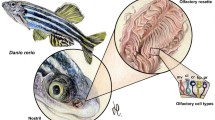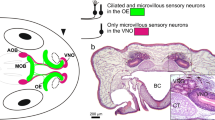Abstract
The olfactory organ of turtles consists of an upper chamber epithelium (UCE) with associated glands, and a lower chamber epithelium (LCE) devoid of glands. The UCE and LCE are referred to as the air-nose and the water-nose, respectively, because the UCE is thought to detect airborne odorants, while the LCE detects waterborne odorants. However, it is not clear how the two are used in the olfactory organ. Odorant receptors (ORs) are the major olfactory receptors in turtles; they are classified as class I and II ORs, distinguished by their primary structure. Class I ORs are suggested to be receptive to water-soluble ligands and class II ORs to volatile ligands. This study analyzed the expression of class I and II ORs in hatchlings of the green sea turtle, Chelonia mydas, through in situ hybridization, to determine the localization of OR-expressing cells in the olfactory organ. Class I OR-expressing cells were distributed mainly in the LCE, implying that the LCE is receptive to waterborne odorants. Class II OR-expressing cells were distributed in both the UCE and LCE, implying that the entire olfactory organ is receptive to airborne odorants. The widespread expression of class II ORs may increase opportunities for sea turtles to sense airborne odorants.










Similar content being viewed by others
Data availability
The data that support the findings of this article are available from the corresponding author upon reasonable request.
References
Abdali SS, Nakamuta S, Yamamoto Y, Nakamuta N (2020) Distribution of cells expressing vomeronasal receptors in the olfactory organ of turtles. J Vet Med Sci 82:1068–1079. https://doi.org/10.1292/jvms.20-0207
Altner H (1962) Untersuchungen uber Leistungen und Bau der Nase des sudafrikanischen Krallenfrosches Xenopus laevis (Daudin, 1803). Z Vergl Physiol 45:272–306. https://doi.org/10.1007/BF00302326
Berghard A, Buck LB (1996) Sensory transduction in vomeronasal neurons: evidence for Gαo, Gαi2, and adenylyl cyclase II as major components of a pheromone signaling cascade. J Neurosci 16:909–918. https://doi.org/10.1523/JNEUROSCI.16-03-00909.1996
Brunet LJ, Gold GH, Ngai J (1996) General anosmia caused by a targeted disruption of the mouse olfactory cyclic nucleotide-gated cation channel. Neuron 17:681–693. https://doi.org/10.1016/S0896-6273(00)80200-7
Brykczynska U, Tzika AC, Rodriguez I, Milinkovitch MC (2013) Contrasted evolution of the vomeronasal receptor repertoires in mammals and squamate reptiles. Genome Biol Evol 5:389–401. https://doi.org/10.1093/gbe/evt013
Buck L, Axel R (1991) A novel multigene family may encode odorant receptors: a molecular basis for odor recognition. Cell 65:175–187. https://doi.org/10.1016/0092-8674(91)90418-X
Constantino MA, Salmon M (2003) Role of chemical and visual cues in food recognition by leatherback posthatchlings (Dermochelys coriacea L). Zoology (Jena) 106:173–181. https://doi.org/10.1078/0944-2006-00114
Dibattista M, Koborssy DA, Genovese F, Reisert J (2021) The functional relevance of olfactory marker protein in the vertebrate olfactory system: a never-ending story. Cell Tissue Res 383:409–427. https://doi.org/10.1007/s00441-020-03349-9
Dulac C, Axel R (1995) A novel family of genes encoding putative pheromone receptors in mammals. Cell 83:195–206. https://doi.org/10.1016/0092-8674(95)90161-2
Eisthen HL (2004) The goldfish knows: olfactory receptor cell morphology predicts receptor gene expression. J Comp Neurol 477(4):341–346. https://doi.org/10.1002/cne.20258
Eisthen HL, Polese G (2007) Evolution of vertebrate olfactory subsystems. In: Kaas JH (ed) Evolution of nervous system, Vol 2. Non-mammalian vertebrates, Academic Press, Oxford, pp 355–406. https://doi.org/10.1016/B0-12-370878-8/00142-7
Endres CS, Lohmann KJ (2012) Perception of dimethyl sulfide (DMS) by loggerhead sea turtles: a possible mechanism for locating high-productivity areas for foraging. J Exp Biol 215:3535–3538. https://doi.org/10.1242/jeb.073221
Endres CS, Putman NF, Lohmann KJ (2009) Perception of airborne odors by loggerhead sea turtles. J Exp Biol 212:3823–3827. https://doi.org/10.1242/jeb.033068
Freitag J, Krieger J, Strotmann J, Breer H (1995) Two classes of olfactory receptors in Xenopus laevis. Neuron 15:1383–1392. https://doi.org/10.1016/0896-6273(95)90016-0
Freitag J, Ludwig G, Andreini I, Rössler P, Breer H (1998) Olfactory receptors in aquatic and terrestrial vertebrates. J Comp Physiol A Neuroethol Sens Neural Behav Physiol 183:635–650. https://doi.org/10.1007/s003590050287
Fülle HJ, Vassar R, Foster DC, Yang RB, Axel R, Garbers DL (1995) A receptor guanylyl cyclase expressed specifically in olfactory sensory neurons. Proc Natl Acad Sci USA 92:3571–3575. https://doi.org/10.1073/pnas.92.8.3571
Getchell ML, Getchell TV (1992) Fine structural aspects of secretion and extrinsic innervation in the olfactory mucosa. Microsc Res Tech 23:111–127. https://doi.org/10.1002/jemt.1070230203
Glusman G, Bahar A, Sharon D, Pilpel Y, White J, Lancet D (2000) The olfactory receptor gene superfamily: data mining, classification, and nomenclature. Mamm Genome 11:1016–1023. https://doi.org/10.1007/s003350010196
Graziadei PPC, Tucker D (1970) Vomeronasal receptors in turtles. Z Zellforsch Mikrosk Anat 105:498–514. https://doi.org/10.1007/BF00335424
Greer PL, Bear DM, Lassance JM, Bloom ML, Tsukahara T, Pashkovski SL, Masuda FK, Nowlan AC, Kirchner R, Hoekstra HE, Datta SR (2016) A family of non-GPCR chemosensors defines an alternative logic for mammalian olfaction. Cell 165(7):1734–1748. https://doi.org/10.1016/j.cell.2016.05.001
Grüneberg H (1973) A ganglion probably belonging to the N. terminalis system in the nasal mucosa of the mouse. Z Anat Entwicklungsgesch 140:39–52. https://doi.org/10.1007/BF00520716
Hansen A, Anderson KT, Finger TE (2004) Differential distribution of olfactory receptor neurons in goldfish: structural and molecular correlates. J Comp Neurol 477(4):347–359. https://doi.org/10.1002/cne.20202
Hansen A, Rolen SH, Anderson K, Morita Y, Caprio J, Finger TE (2003) Correlation between olfactory receptor cell type and function in the channel catfish. J Neurosci 23(28):9328–9339. https://doi.org/10.1523/JNEUROSCI.23-28-09328.2003
Hatanaka T, Matsuzaki O, Shibuya T (1982) Fine structure of vomeronasal receptor cells in the Reeve’s turtle, Geoclemys reevesii. Zool Mag 91:190–193. https://doi.org/10.34435/zm004925
Herrada G, Dulac C (1997) A novel family of putative pheromone receptors in mammals with a topographically organized and sexually dimorphic distribution. Cell 90:763–773. https://doi.org/10.1016/S0092-8674(00)80536-X
Kondoh D, Kitayama C, Yamaguchi Y, Yamagawa M, Kawai YK, Suzuki C, Itakura R, Fujimoto A, Satow T, Kondo S, Sato T (2019) Nasal cavity of green sea turtles contains 3 independent sensory epithelia. Chem Senses 44:427–434. https://doi.org/10.1093/chemse/bjz033
Kumar S, Stecher G, Tamura K (2016) MEGA7: Molecular evolutionary genetics analysis version 7.0 for bigger datasets. Mol Biol Evol 33:1870–1874. https://doi.org/10.1093/molbev/msw054
Liberles SD, Buck LB (2006) A second class of chemosensory receptors in the olfactory epithelium. Nature 442:645–650. https://doi.org/10.1038/nature05066
Liberles SD, Horowitz LF, Kuang D, Contos JJ, Wilson KL, Siltberg-Liberles J, Liberles DA, Buck LB (2009) Formyl peptide receptors are candidate chemosensory receptors in the vomeronasal organ. Proc Natl Acad Sci USA 106:9842–9847. https://doi.org/10.1073/pnas.0904464106
Liman ER, Corey DP, Dulac C (1999) TRP2: a candidate transduction channel for mammalian pheromone sensory signaling. Proc Natl Acad Sci USA 96:5791–5796. https://doi.org/10.1073/pnas.96.10.5791
Matsunami H, Buck LB (1997) A multigene family encoding a diverse array of putative pheromone receptors in mammals. Cell 90:775–784. https://doi.org/10.1016/S0092-8674(00)80537-1
Mezler M, Fleischer J, Breer H (2001) Characteristic features and ligand specificity of the two olfactory receptor classes from Xenopus laevis. J Exp Biol 204:2987–2997. https://doi.org/10.1242/jeb.204.17.2987
Morreale SJ, Ruiz GJ, Spotila JR, Standora EA (1982) Temperature-dependent sex determination: Current practices threaten conservation of sea turtles. Science 216:1245–1247. https://doi.org/10.1126/science.7079758
Nakada T, Hagino-Yamagishi K, Nakanishi K, Yokosuka M, Saito TR, Toyoda F, Hasunuma I, Nakakura T, Kikuyama S (2014) Expression of G proteins in the olfactory receptor neurons of the newt Cynops pyrrhogaster: their unique projection into the olfactory bulbs. J Comp Neurol 522(15):3501–3519. https://doi.org/10.1002/cne.23619
Nakamuta N, Nakamuta S, Kato H, Yamamoto Y (2016) Morphological study on the olfactory systems of the snapping turtle, Chelydra serpentina. Tissue Cell 48:145–151. https://doi.org/10.1016/j.tice.2016.03.011
Nakamuta S, Yamamoto Y, Miyazaki M, Sakuma A, Nikaido M, Nakamuta N (2023) Type 1 vomeronasal receptors expressed in the olfactory organs of two African lungfish, Protopterus annectens and Protopterus amphibius. J Comp Neurol 531:116–131. https://doi.org/10.1002/cne.25416
Nakamuta S, Yokosuka M, Taniguchi K, Yamamoto Y, Nakamuta N (2016) Immunohistochemical analysis for G protein in the olfactory organs of soft-shelled turtle, Pelodiscus sinensis. J Vet Med Sci 78:245–250. https://doi.org/10.1292/jvms.15-0359
Niimura Y (2012) Olfactory receptor multigene family in vertebrates: from the viewpoint of evolutionary genomics. Curr Genomics 13:103–114. https://doi.org/10.2174/138920212799860706
Niimura Y, Nei M (2005) Evolutionary dynamics of olfactory receptor genes in fishes and tetrapods. Proc Natl Acad Sci USA 102:6039–6044. https://doi.org/10.1073/pnas.0501922102
Parsons TS (1970) The nose and Jacobson’s organ. In: Gans C, Parsons TS (eds) Biology of the reptilia, vol 2. Academic Press, New York, pp 99–191
Piovano S, Balletto E, Di Marco S, Dominici A, Giacoma C, Zanetti A (2004) Loggerhead turtle (Caretta caretta) bycatches on long-lines: the importance of olfactory stimuli. Ital J Zool 71:213–216. https://doi.org/10.1080/11250000409356638
Rivière S, Challet L, Fluegge D, Spehr M, Rodriguez I (2009) Formyl peptide receptor-like proteins are a novel family of vomeronasal chemosensors. Nature 459:574–577. https://doi.org/10.1038/nature08029
Rodolfo-Masera T (1943) Su lésistenza di un particolare organo olfactivo nel setto nasale della cavia e di altri roditori. Arch Ital Anat Embryol 48:157–212
Saito K, Shoji T, Uchida I, Ueda H (2000) Structure of the olfactory and vomeronasal epithelia in the loggerhead turtle Caretta caretta. Fish Sci 66:409–411. https://doi.org/10.1046/j.1444-2906.2000.00065.x
Sato Y, Miyasaka N, Yoshihara Y (2005) Mutually exclusive glomerular innervation by two distinct types of olfactory sensory neurons revealed in transgenic zebrafish. J Neurosci 25:4889–4897. https://doi.org/10.1523/JNEUROSCI.0679-05.2005
Schwenk K (2008) Comparative anatomy and physiology of chemical senses in nonavian aquatic reptiles. In: Thewissen JGM and Nummela S (eds) Sensory evolution on the threshold, Univ. of California Press, Berkley, pp 65–81. https://doi.org/10.1525/california/9780520252783.003.0005
Taniguchi K, Taniguchi K (2014) Phylogenic studies on the olfactory system in vertebrates. J Vet Med Sci 76:781–788. https://doi.org/10.1292/jvms.10-0316
Wakabayashi Y, Ichikawa M (2008) Localization of G protein alpha subunits and morphology of receptor neurons in olfactory and vomeronasal epithelia in Reeve’s turtle, Geoclemys reevesii. Zoolog Sci 25:178–187. https://doi.org/10.2108/zsj.25.178
Wakabayashi Y, Ohkura S, Okamura H, Mori Y, Ichikawa M (2007) Expression of a vomeronasal receptor gene (V1r) and G protein α subunits in goat, Capra hircus, olfactory receptor neurons. J Comp Neurol 503:371–380. https://doi.org/10.1002/cne.21394
Wang Z, Pascual-Anaya J, Zadissa A, Li W, Niimura Y, Huang Z, Li C, White S, Xiong Z, Fang D, Wang B, Ming Y, Chen Y, Zheng Y, Kuraku S, Pignatelli M, Herrero J, Beal K, Nozawa M, Li Q, Wang J, Zhang H, Yu L, Shigenobu S, Wang J, Liu J, Flicek P, Searle S, Wang J, Kuratani S, Yin Y, Aken B, Zhang G, Irie N (2013) The draft genomes of soft-shell turtle and green sea turtle yield insights into the development and evolution of the turtle-specific body plan. Nat Genet 45:701–706. https://doi.org/10.1038/ng.2615
Zhang X, Firestein S (2002) The olfactory receptor gene superfamily of the mouse. Nat Neurosci 5:124–133. https://doi.org/10.1038/nn800
Acknowledgments
We thank Haruka Sasaki for technical assistance with primer designing, tissue sectioning, and tissue processing. We thank Asahi Nakamuta for expert assistance with phylogenetic analysis.
Author information
Authors and Affiliations
Contributions
Conceptualization, SN, NN; Sample preparation, MM, MI, MK.; Investigation, SN; Data analysis, NN; Wrote paper, NN; Supervision, MM, YY. All authors have read and agreed to the final version of the manuscript.
Corresponding author
Ethics declarations
Ethical approval
This study was approved by the Animal Ethics Committee of Iwate University (approval no. A202143).
Informed consent
Not Applicable
Conflict of interests
The authors declare that the research was conducted in the absence of any commercial or financial relationships that could be construed as a potential conflict of interest.
Additional information
Publisher's Note
Springer Nature remains neutral with regard to jurisdictional claims in published maps and institutional affiliations.
Supplementary Information
Below is the link to the electronic supplementary material.
Rights and permissions
Springer Nature or its licensor (e.g. a society or other partner) holds exclusive rights to this article under a publishing agreement with the author(s) or other rightsholder(s); author self-archiving of the accepted manuscript version of this article is solely governed by the terms of such publishing agreement and applicable law.
About this article
Cite this article
Nakamuta, S., Mori, M., Ito, M. et al. In situ hybridization analysis of olfactory receptor expression in the sea turtle olfactory organ. Cell Tissue Res 393, 253–264 (2023). https://doi.org/10.1007/s00441-023-03782-6
Received:
Accepted:
Published:
Issue Date:
DOI: https://doi.org/10.1007/s00441-023-03782-6




